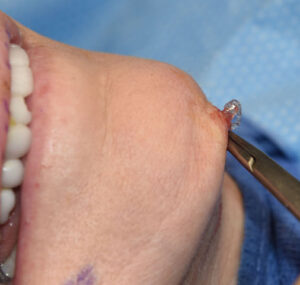Chin augmentation can be done by a wide variety of methods from injectable fillers or fat, implants and repositioning the end of the chin bone. These augmentation options represent an increasingly level of invasiveness/scope of surgery in which patients can go up or down on these progressive treatment…although it is far more common to go upward in these types of treatment that down.
The most progressive treatment is when synthetic injectable fillers, typically of the HA variety, are first used for a trial chin augmentation effect. Thereafter, if it has an aesthetically pleasing effect, a surgical approach can be done to commonly place an implant. This always raises the question of whether the injectable HA filler should be dissolved before the implant surgery. This question is largely relevant from trying to determine what style and size of chin implant to use.
But another consideration is whether the injectable filler will be encountered during the course of a submental dissection down to the chin bone. (this is not a concern with any intraoral approach) And if encountered could it be a source of potential infection as it is a non-biologic tissue element which could theoretically allow for bacterial to track inside the chin pad soft tissues?

Whether HA fillers should be dissolved before any form of chin augmentation surgery depends on how much filler has been injected and how long it has been there. Given that the average volume of a chin implant is 2ccs or higher more than 1cc of filler should be dissolved beforehand to help accurately gauge the effect of the implant. But almost regardless of the HA filler volume if it is 9 months or longer since it was placed then there is no need to do so as much of the filler may already have dissolved..
Dr. Barry Eppley
Indianapolis, Indiana



